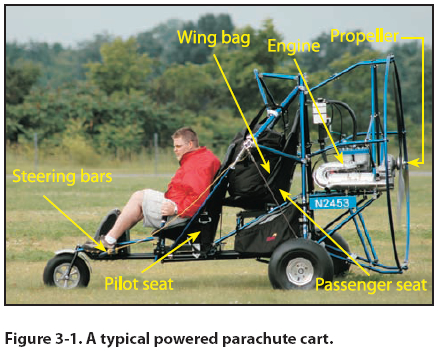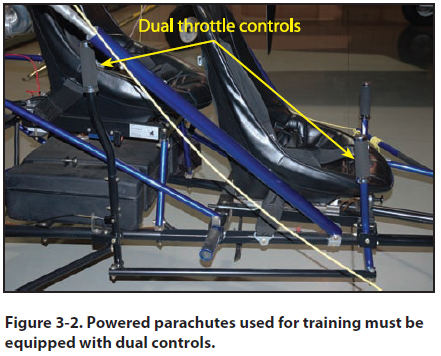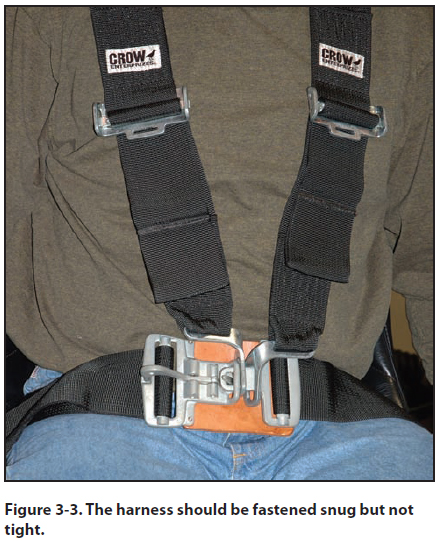|

Although powered parachutes come in an array of
shapes and sizes, the basic design features are fundamentally
the same. All powered parachutes consist
of an airframe (referred to as a cart) a propeller
powered by an engine, and a ram-air inflated wing.
[Figure 3-1]

The Airframe
Most powered parachute airframes are manufactured
with aircraft-grade hardware. A few PPC manufacturers
are building fiber-composite carts. The airframe’s
tubular construction means light weight and ease of
replacement if tubes are bent. The airframe includes
one or two seats, flight controls, and an instrument
panel. The airframe also incorporates the engine, the
fuel tank, the propeller and points of attachment for
the wing and steering lines.
Although side-by-side configurations exist, in most
powered parachutes the pilot and passenger are seated
in a tandem (fore and aft) configuration. Dual flight
controls are required for training. Not all PPCs have
full dual controls; depending on the configuration of
the cart and added controls (that are optional from
different airframe manufacturers) the flight instructor
can adequately control the aircraft during training
from the rear seat during takeoff, flight, and landing
procedures with dual throttle controls. While in the rear seat, the flight instructor can have positive control
of the aircraft at all times by physically pulling
on the steering lines and using a dual control throttle.
Like airplanes, not all powered parachutes are adequately
configured to conduct flight training. The
flight instructor with a powered parachute endorsement
should determine his or her ability to control
each individual PPC from the back seat with the dual
controls for training purposes. [Figure 3-2]

The pilot flies from the front seat in order to reach the
steering bars, throttle control, ground steering control
and magneto switches, and to keep the CG in balance;
you cannot fly alone from the back seat for this reason.
The cart by itself is not very aerodynamic because
it does not need to be; it flies at slower airspeeds.
However, without the wing attached and inflated to
limit speed, the pilot needs to be careful to avoid high
speeds, such as when taxiing to and from the hangar
for canopy layout. The wheels, their bearings, and
the cart suspension were not designed to handle high
speeds.
Some manufacturers use an adjustable front seat
to allow for the varied length of the pilot’s legs
to comfortably reach the steering bars. Powered parachutes can be outfitted with a variety of seatbelts,
including a four-point harness system that
securely fastens each occupant into their seat.
[Figure 3-3]

Most powered parachutes have three wheels, or a tricycle
gear configuration, although some have four.
Ground steering is typically a steering bar connected
to the nosewheel that moves left and right. Some powered
parachutes have a tiller device for ground steering.
There are a number of ground steering designs
that vary between manufacturer, make, and model.
Brakes are an optional piece of equipment on the
powered parachute, as the square foot area of the
parachute itself provides aerodynamic braking. Pilots
should use smooth and controlled operation of the
throttle on the ground to maintain safe and controllable
ground speeds, particularly when taxiing with
the chute inflated. Students should practice throttle
control to learn how far the PPC takes to come to a
full stop when the power is reduced to idle. However,
for runway incursion prevention and general safety,
brakes are advised and highly recommended so you
can stop when you need to. Never use your feet as a
form of braking, as physical injury is probable.
|

